Contesting the sovereignty of early modern Ireland
Published in Early Modern History (1500–1700), Features, Issue 6 (Nov/Dec 2007), Volume 15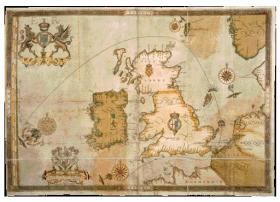
Map of the British Isles c. 1588. (British Library)
Students of the early modern period may be presented with a relatively straightforward history of Ireland’s sovereignty: the rapid military domination of a politically fragmented Gaelic polity by subjects of the king of England—beginning two decades or so after the pope’s grant of the island, by right of the so-called Donation of Constantine, to King Henry II in 1156—resulted in the creation of what Englishmen dubbed the ‘lordship of Ireland’, an ambiguous dominion which, with the succession to the English throne in 1199 of Henry II’s youngest son John, ‘lord of Ireland’, became an appendage of the English crown. The lordship was erected into a kingdom when, in 1541, Henry VIII was proclaimed Ireland’s first English king; the kingdom later passed, along with England and Wales, from the Tudors to King James VI of Scotland, to form part of a multiple monarchy under the Stuarts (and briefly part of a republican Commonwealth under Oliver Cromwell) in the seventeenth century. Yet an explanation of Ireland’s sovereignty from medieval to early modern times would hardly be presented in this manner. To do so would be to ignore the glaring fact that the English crown’s sovereignty over Ireland was achieved with overwhelming force and against the will of a substantial segment of the native population of the island. Here the question of an English monarch’s ‘right’ to rule over Ireland comes into play. For many Irish nationalists, the continued existence of a culture (and later a religion) that was distinctly not English, or British, belies the right of English kings and queens to the sovereignty of Ireland. Native assertions of that sovereignty in the early modern period (however unsuccessful) are perhaps the clearest expressions for nationalists of the existence of a proto-national consciousness and the rejection of foreign rule.
The difficulty that nationalists encounter when considering the early modern period is that native claims to Ireland’s sovereignty were rare, and grew ever more so as the age progressed. Historians have argued that the concept of Ireland as a sovereign nation-state belongs to the late eighteenth century, and that in late medieval Gaeldom ‘Ireland’ was a component (albeit the most important one) of a larger region encompassing Gaelic parts of Scotland, known as the Gaedhealtacht—a district based more on commonality of culture and language than on loyalty to the same sovereign and agreed lines on a map. It has been convincingly shown, moreover, that in the wake of the Tudor conquest the Gaelic political and intellectual élite altered their traditional world-view so as to accept the Stuarts as Ireland’s rightful kings. Historians, however, have been slower to draw attention to native attempts to vest the sovereignty of Ireland in princes who were not also kings of England. That there were in the early modern period examples of this phenomenon sits uncomfortably not only with nationalists but also with historians who would seek to explain Ireland’s sovereignty strictly in ‘British’ terms. This article will identify the last examples of native claims to Ireland’s sovereignty and highlight the unsuccessful efforts in the early modern period to define the sovereignty of Ireland in terms outside of an Irish or British context.

Recent anti-M3 protest at Tara, the ancient seat of the Ard Rí na hÉireann, or high king of Ireland. (Paula Geraghty)
The English conquest of Ireland in the twelfth century extinguished the Gaelic high kingship of Ireland. There were, to be sure, attempts in the later medieval period by provincial kings (and, in 1315, Edward the Bruce) to revive the high kingship. But the kingship had never been, even before the king of England set foot in Ireland, an institutional reality in the Gaelic world, and no subsequent Gaelic claimant would come as close as the twelfth-century Gaelic kings to establishing his authority over the entire island. Notions of the high kingship lived on into the fifteenth century, however—and not only in the mind of John MacDonald, the last Lord of the Isles, who considered a progress through Meath to the Hill of Tara (reputedly the ancient seat of the Ard Rí na hÉireann, or high king of Ireland), or in the grandiloquent words of the Gaelic poet who viewed the sovereignty of Ireland and Scotland as belonging to MacDonald. In 1468 Roland FitzEustace, Baron Portlester, was accused of treason for having allegedly pressed the earl of Desmond to make himself king of Ireland. That Desmond, an Englishman by blood, was not eligible by Gaelic custom for the high kingship did not matter—in the minds of some Englishmen, the pursuit of the kingship by a subject of the English crown represented the ultimate act of betrayal. Thus, though existing into Tudor times only in hyperbole and innuendo, the high kingship still carried a powerful symbolism. It would take the upheaval wrought by Henry VIII’s breach with Rome and the destruction of the earls of Kildare to create a situation in which the installation of a high king might again become a reality.
A national Gaelic confederation emerged in the late 1530s as a response to the rapid political and religious changes of Henry’s reign. Known to historians as the ‘Geraldine League’, it was the first of its kind since the assembly in 1258 of a short-lived coalition of provincial kings under the leadership of Brian O’Neill. The Geraldine League was led by Brian O’Neill’s descendant, Conn Bacach O’Neill, and its principal aim was the restoration of the earls of Kildare. But following the departure to the Continent in 1539 of the fugitive heir to the earldom, the confederation’s goals changed. Rumours spread among English officials that Conn Bacach intended to march on the Hill of Tara and be proclaimed high king. In 1539 O’Neill was reputed to have received a letter in which Pope Paul III styled him ‘King of our Realm of Ireland’, an implicit revocation of Laudabiliter, Adrian IV’s twelfth-century grant of Ireland to the king of England and his successors.
Yet it is unlikely that O’Neill ever claimed the high kingship at Tara. We learn from Gaelic sources only that he and O’Donnell mounted a large spoiling raid into the county of Meath, the English administrative unit that for centuries had housed the Hill of Tara; no mention is made of his having been made king there or anywhere else. O’Neill, moreover, suffered a crushing defeat shortly thereafter at the hands of the English lord deputy, and his coalition limped back to Ulster a broken military force. That rumours of O’Neill’s pursuit of the high kingship are found entirely in English sources is significant. With the Reformation dividing western Christendom, and with Rome having made clear its support for O’Neill, the ambiguity of the English crown’s relationship to Ireland had become untenable. At this uncertain juncture, a native claim to Ireland’s sovereignty with full papal backing was a nightmare scenario for the Tudor regime. It was in this context that a new policy, which sought the Gaelic polity’s integration into the Tudor state and saw Henry VIII proclaimed Ireland’s king, was introduced in the early 1540s. Conn O’Neill’s transformation in these years was striking: the man who would be king not only travelled to London to accept the sovereignty of the English crown and an English noble title, he also abjured papal authority. O’Neill was not alone, of course: dozens of Gaelic chiefs—some of them descended from high kings themselves—concluded similar agreements with the new king of Ireland.
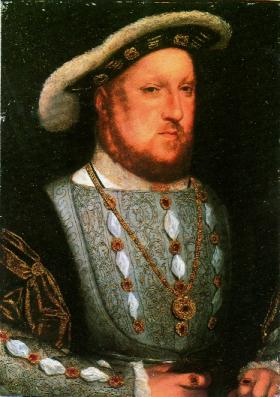
Henry VIII at the time he was proclaimed Ireland’s first English king in 1541. (Thyssen-Bornemisza, Madrid)
Never again would a Gaelic leader be associated, even by rumour, with the old-style high kingship that Tara represented. Even Conn Bacach’s illustrious grandson, Hugh O’Neill, earl of Tyrone—the leader of a Gaelic confederation whose military ability and political reach exceeded that of any previous Gaelic movement—did not go so far as to assert a native claim to Ireland’s sovereignty. When opportunity to do so presented itself in 1595, during the exiled bishop of Killaloe’s campaign to convince the pope to use his powers to have O’Neill formally declared king of Ireland, he did not avail of it. Rather, O’Neill alternated between efforts to improve the native position (and most especially his own) in an Ireland that would continue under the rule of an English monarch and attempts to invest the kingdom in another European prince. In his political manifesto of 1599, O’Neill—far from seeking to turn back the clock to a time before the kings of England intruded on Ireland’s sovereignty—demanded ‘That the Governor of Ireland be at least an earl, and of the Privy Council of England’. In this way, O’Neill demonstrated his willingness to acknowledge an English monarch’s right to be Ireland’s sovereign, provided that his own power was safeguarded. When negotiating for Spanish military assistance, however, O’Neill changed tack, pledging the Irish crown to the Spanish king or his Habsburg kinsman, Cardinal Albert, archduke of Austria. It was this tension between whether the kingdom of Ireland would remain held of the English crown or be invested in a Continental prince that dominated the question of the island’s sovereignty in the Tudor period.
In attempting to place Ireland under the rule of a foreign prince, Hugh O’Neill was continuing in a minority tradition that had gained in strength since Henry VIII’s split with Rome. Some Gaelic chiefs had always maintained that the right of English kings to Ireland was based solely on conquest. In a letter written during Kildare’s rebellion, Conor O’Brien explained to Charles V, the Holy Roman Emperor, that
‘Our predecessors for a long time quietly and peacefully occupied Ireland . . . They possessed and governed this country in manner royal, as by our ancient chronicles doth plainly appear . . . our predecessors and ancestry did come from your Majesty’s realm of Spain, where they were of the blood of a Spanish prince, and many kings of that lineage, in long succession, governed all Ireland happily, until it was conquered by the English.’
O’Brien’s reference to the alleged Milesian ancestry of the Gaels little interested the emperor; that it came at a time when the king of England had rejected papal authority was a different matter. For Catholic monarchs, rebellious Tudor nobles and disgruntled Gaelic chiefs alike, the schism invalidated Henry VIII’s claim to Ireland’s sovereignty. Thus, when in 1534 Kildare launched his rebellion, he could couch in religious terms what was meant to be a demonstration of his political indispensability to the English crown, promising pope and emperor that he would in future hold his earldom of their authority. Similarly, the Geraldine League offered their allegiance and the sovereignty of Ireland to James V, the Catholic king of Scotland, and (after James proved uninterested) to the emperor himself. Nothing came of any of these designs, but they stand in marked contrast to the earl of Desmond’s unsuccessful foreign intrigues undertaken prior to Henry’s break with Rome. In 1523 Desmond had offered his allegiance to Henry’s then enemy, Francis I of France; he did so, however, as part of the latter’s plan to place Richard de la Pole, the Yorkist pretender (and self-styled duke of Suffolk), on the English throne. Not unlike his predecessor, who had supported Perkin Warbeck’s claims to the throne, Desmond sought to replace one English lord of Ireland with another. Desmond again transferred his loyalty in 1529—this time to Henry’s adversary Charles V—and, though he swore to be the emperor’s ‘especial and particular subject’, the earl stopped short of attempting to place the lordship of Ireland under Habsburg rule.
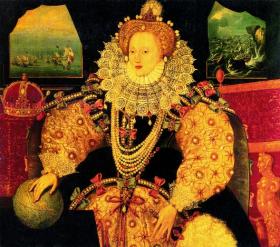
Elizabeth I—although she was excommunicated by Pope Pius V in 1570, it was not until the 1580s that Philip II resolved to topple his erstwhile ally from the English throne and to vest Ireland’s sovereignty in a Continental prince. (National Portrait Gallery, London)
The policy begun in the early 1540s of integrating the new kingdom of Ireland into the Tudor state created an atmosphere in which an English monarch was acceptable to a majority of Ireland’s inhabitants; but the inconsistent and coercive methods of governing employed by Henry VIII’s children (and the Elizabethan regime in particular) did much to undermine any legitimacy won late in the old king’s reign. After the 1540s every decade of the sixteenth century witnessed disaffected Tudor subjects, of both Gaelic and Old English stock, intriguing with Continental sovereigns. Efforts to transfer Ireland’s sovereignty to another prince, which had all but died out with the disintegration of the Geraldine League, began anew, and the Spanish king, Philip II, became the favourite choice to aid in delivering Ireland a non-English sovereign. In 1559 an Irishman who travelled to the Spanish court purporting to represent a confederacy of Irish lords offered the kingship of Ireland to a prince of Philip’s choice; a decade later the Munster rebel James Fitzmaurice dispatched the papal archbishop of Cashel to Spain in an effort to persuade Philip to nominate a new king of Ireland for papal confirmation. That Philip II was the aggressive leader of the temporal wing of Counter-Reformation Catholicism, and that he was, following Elizabeth’s accession in 1558, the former husband of Mary Tudor and thus briefly king of Ireland, made him a magnet for dissident Irishmen. But continued good relations with England were essential if Philip was to maintain leverage over France: even Pius V’s excommunication of Elizabeth in 1570 did not impel Philip to contest Ireland’s sovereignty.
It was not until the 1580s, when Philip II resolved to topple his erstwhile ally from the English throne, that dissidents’ schemes to vest Ireland’s sovereignty in a foreign prince became a real possibility. The men who followed the earl of Desmond and Viscount Baltinglass into rebellion in 1579–80 were sufficiently confident of Spanish aid to seek assurances from their leadership that their possessions would be undisturbed following a Spanish takeover of Ireland. The intensification of Protestant power in the kingdom following the defeat of Desmond and Baltinglass moved the growing Irish Catholic exile population to put a face to an alternative Irish sovereign by proposing in 1588 Philip’s nephew, Archduke Albert, as Ireland’s new king. The archduke’s claim was later strengthened by his marriage to Isabella, the Spanish infanta, whom Philip II had put forth as the rightful queen of England owing to her descent from Edward III. The Iberian origins of Ireland’s inhabitants again featured prominently in dissident arguments that the Irish crown rightfully belonged to Spain. But Philip II did not live to see the Spanish invasion of Ireland. It was under his successor, Philip III, that a sizeable Spanish army made landfall in Ireland to aid Hugh O’Neill in his war to overthrow English rule. The rout of O’Neill outside Kinsale in December 1601, and the subsequent surrender of the Spanish force there, however, alerted Philip III to the difficulties involved in making a military success of an amphibious landing in Ireland. After Kinsale Spanish plans to conquer Ireland and crown Archduke Albert king were abandoned in favour of strategies calling for a direct assault on England. Albert, the Spanish reasoned, would have his Irish kingdom, but not before the infanta either dethroned or succeeded Elizabeth.
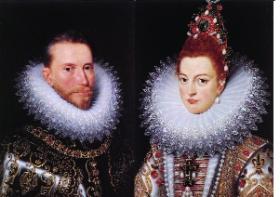
Archduke Albert of Austria and his wife Isabella—Philip proposed Albert, his nephew, as Ireland’s new king in 1588, a claim strengthened by his marriage to Isabella, the Spanish infanta, whom Philip had put forth as the rightful queen of England owing to her descent from Edward III. (Groeninge Museum, Bruges)
The union of the crowns in James VI brought a new dimension to the struggle for Ireland’s sovereignty. Unencumbered by the baggage of history and conquest that accompanied English kings, James was accepted by the Gaelic élite as Ireland’s lawful sovereign and cast in the role of a traditional Gaelic king. Ireland’s Catholic Old English population, meanwhile, cast their new king as a sovereign who would allow them the free practice of their religion. Though James proved no more sympathetic to Gaelic culture than to Catholicism, all shades of Ireland’s population now recognised the Stuarts as the kingdom’s legitimate sovereigns. The same was true of Continental princes: James ended England’s long war with Spain in 1604 and thereafter steered his three kingdoms away from open conflict with Continental powers. The result was that efforts by dissident Irishmen to invest the sovereignty of Ireland in a person other than a British king all but disappeared in James’s reign.
This changed attitude toward Ireland’s sovereignty at home and abroad was in keeping with the prevailing mood of peace and religious toleration in early seventeenth-century Europe. More remarkable, however, was the fact that an overwhelming majority of Ireland’s inhabitants maintained their attachment to their Stuart sovereigns through the religious and social upheaval that beset the Continent and the Stuart kingdoms at mid-century. With the Thirty Years’ War raging in Europe and with James’s successor Charles I at war with Scotland, and on the verge of civil war in England, it might have been expected that the bloody rising begun by native Irishmen in Ulster, which evolved by 1642 into a national Catholic confederacy, would produce a new king. The confederacy, however, did not seek a new sovereign. Rather the confederates, whose motto ‘For God, King and Fatherland, Ireland united’ adorned their government’s seal of office, hoped to secure religious and constitutional concessions from Charles I while remaining firmly within a British political context. There were dissenting voices, most notably the Lisbon-based Jesuit Conor O’Mahony, whose Disputatio apologetica (1645) urged the confederates to follow Portugal’s example and elect a native king. O’Mahony’s virulent anti-Englishness may have spoken to a segment of Ireland’s Gaelic, or ‘Old Irish’, population—some Protestants who survived the 1641 rising recalled Gaelic insurgents’ dark threats to make one of their own king of Ireland. But the confederates’ loyalty lay with Charles I and, after the latter’s execution in 1649, with his son, Charles II: O’Mahony’s radical book was hastily suppressed.
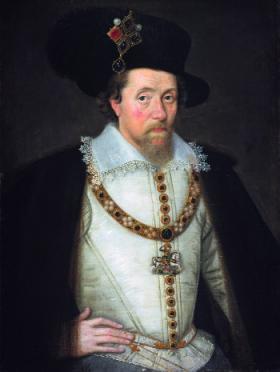
James I/VI—accepted by the Gaelic élite as Ireland’s lawful sovereign and cast in the role of a traditional Gaelic king. (National Portrait Gallery, London)
A more prominent strain of thought to emerge among the confederates as the Stuarts’ fortunes steadily declined was to procure military assistance from a Catholic nobleman on the Continent. Exiled from his lands but an experienced military commander who had grown wealthy in the service of the Habsburgs, Charles IV, duke of Lorraine, was an ideal candidate. But even as Cromwell’s parliamentarian army threw the confederacy on its heels after 1649, the confederate leadership was divided over whether to seek what its clerical wing referred to as a ‘Catholic Protector’ for Ireland. From the 1640s rumours had circulated in Europe that the Irish might offer the kingdom to Lorraine; that the duke’s personal ambitions were unclear did little to dispel such idle talk. In 1651 the staunchly royalist marquis of Clanricarde attacked the confederate assembly’s treaty that permitted Lorraine to garrison Galway and Limerick as surety for a loan of £20,000. The treaty, Clanricarde argued, was ‘no better than a total transferring of the Crown from his Majesty to a foreign Prince’. The Protestant duke of Ormond, lord lieutenant of Ireland, identified the Irish Catholic clergy as the root of the trouble, claiming that they ‘had long endeavoured to bring that nation to a necessity of calling for a Roman Catholic Protector from which office to absolute sovereignty is straight and easy’. It was, in the end, fear among the confederate leadership that the kingdom of Ireland would be lost for the Stuarts that cost the confederacy the military support it so desperately needed.
Conclusion
A survey of Ireland’s sovereignty in the early modern period offers something for all historians, whether they seek to interpret Ireland’s history from a national, a British or a European perspective. Nationalists may point to the fact that though efforts to establish a native sovereign of Ireland were unsuccessful, and though they often ran against the interests of a pragmatic ruling élite, they were in evidence into the 1640s and may be seen as representing a cultural feeling that had yet to find its full political expression. But the British context of Ireland’s sovereignty must not be overlooked. Kings of England claimed sovereignty over the island throughout the period and were the only claimants to that sovereignty whose authority was regularly felt there. At the same time a European perspective is necessary to explain the repeated involvement of Continental monarchs and noblemen in the struggle for Ireland’s sovereignty. Exploring the history of a nation’s sovereignty is a delicate task for the historian because his findings seldom match up with the romantic and often one-dimensional histories from which modern nation-states draw their legitimacy. The matter of Ireland’s sovereignty in the early modern period, it would appear, is no different.
Christopher Maginn is Assistant Professor of History at Fordham University, New York.
Further reading:
S. Ellis with C. Maginn, The making of the British Isles: the state of Britain and Ireland, 1450–1660 (London, 2007).
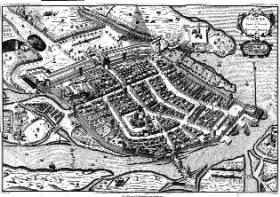
Map of Galway drawn up in 1651 for Charles IV, duke of Lorraine. Rumours circulated in Europe that he might be offered the kingship of Ireland.
B. Ó Buachalla, Aisling ghéar na Stíobhartaigh agus an t-aos léinn, 1603–1788 (Dublin, 1996).
M. Ó Siochrú, ‘The duke of Lorraine and the international struggle for Ireland, 1649–1653’, Historical Journal 48 (4) (2005), 905–32.
J.J. Silke, Ireland and Europe, 1559–1607 (Dundalk, 1966).
















